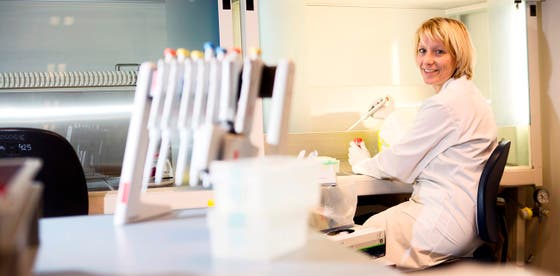Feb. 20: Another HIV cure after stem cell transplant

After four years of thorough observation, an international team of researchers has been able to determine that they have once again cured a patient with HIV. The HIV infection disappeared after the patient received a stem cell transplant as part of a therapy for leukemia. The patient - who is under treatment at the University Hospital of Düsseldorf - is part of the European IciStem program coordinated by UMC Utrecht.
The so-called "Düsseldorf patient," a 53-year-old man, is the third patient in the world to be completely cured of HIV through a stem cell transplant, details of which have been published in the scientific literature. The transplant, like the two previous patients (the 'Berlin patient' and the 'London patient'; the latter was also part of the IciStem program), took place because the patient had been diagnosed with acute severe hematological disease (acute myeloid leukemia (AML)), which had developed alongside an HIV infection. In a publication in Nature Medicine, the medical team presents the path to cure for this patient. Ten years after his stem cell transplant and more than four years after stopping HIV therapy, this patient is now in good health. The fact that the virus has not returned is the result of careful scientific and therapeutic preparation and monitoring. Although the two previous patients have also been published in scientific journals, this new publication describes in detail the longest and most detailed follow-up of a patient with HIV after stem cell transplantation to date.
Leads for future studies
The research team hopes that the knowledge gained will provide further leads for planning future studies on curing HIV. Because of the high risks, stem cell transplantation can only be used as part of the treatment of other life-threatening diseases. Therefore, it is now important to continue the research so that patients can overcome HIV infection in the future even without this procedure.
The "Düsseldorf patient" was diagnosed with AML six months after starting his HIV therapy. AML is a form of blood cancer that is life-threatening for the patient. In 2013, he therefore had to undergo a stem cell transplant. The goal of this transplant was to control both the leukemia and HIV. For this purpose, stem cells were used from a donor with a specific gene defect: a mutation of the CCR5 gene (CCR5Δ mutation). This rare mutation, which occurs mainly in central and northern Europe, lacks an attachment site for HIV on immune cells, providing comprehensive protection against infection by HIV.
Cure
In 2018, after careful planning and with intensive, close monitoring by the medical team, antiviral therapy, which until then would have provided control of any residual HIV, was finally discontinued. In order to finally speak of a cure, the patient underwent regular and extensive examinations throughout the period. For example, whether there was still evidence of replicable HIV. In the publication, the authors describe in detail how they examined the patient to rule out a still active HIV infection, so that they can now speak of cure after stem cell transplantation.
Dr. Annemarie Wensing (Department of Medical Microbiology, UMC Utrecht), coordinator of the IciStem project and one of the principal investigators says, "Through this research, supported by the Aidsfonds, we can now confirm that it is in principle possible to permanently prevent the replication of HIV. Despite finding fragments of HIV in blood and tissues, there is no viral rebound four years after discontinuing antiviral therapy. It seems that the immune system "forgets" the virus, so to speak. Reprogramming the immune system by disabling the CCR5 receptor has again proven successful. It is important that funds are now being released to translate this into a more widely applicable treatment."
IciStem
IciStem is a European consortium to investigate the potential of HIV cure in patients with HIV who require stem cell transplantation for hematological disorders. The consortium is composed of an expert review panel of hematologists with experience in stem cell transplantation along with infectious disease specialists, virologists and immunologists with expertise in HIV-1 tropism, reservoirs and treatment. The investigators prospectively study recipients of stem cell therapy with HIV infection and collect complete information on the underlying malignancy, chemotherapy, transplant procedure, donor selection, HIV tropism, antiviral therapy, and virologic and immunologic characteristics before and after transplantation.
Publication
Jensen BO, Knops E, Cords L, Lübke N, Salgado M, Busman-Sahay K, Estes JD, Huyveneers LEP, Perdomo-Celis F, Wittner M, Galves C, Mummert C, Passaes C, Eberhard JM, Münk C, Hauber I, Hauber J, Heger E, De Clercq J, Vandekerckhove L, Bergmann S, Dunay GA, Klein F, Häussinger D, Fischer JC, Nachtkamp K, Timm J, Kaiser R, Harrer T, Lüdde T, Nijhuis M, Saez-Cirion A, Schilze zur Wiesch J, Wensing AMJ, Martinez-Picado J, Kobbe G. In-depth virological and immunological characterization of HIV-cure after CCR5Δ32/Δ32 allogenic hematopoietic stem cell transplantation. Nature Medicine 2023, DOI: 10.1038/s41591-023-02213-x
